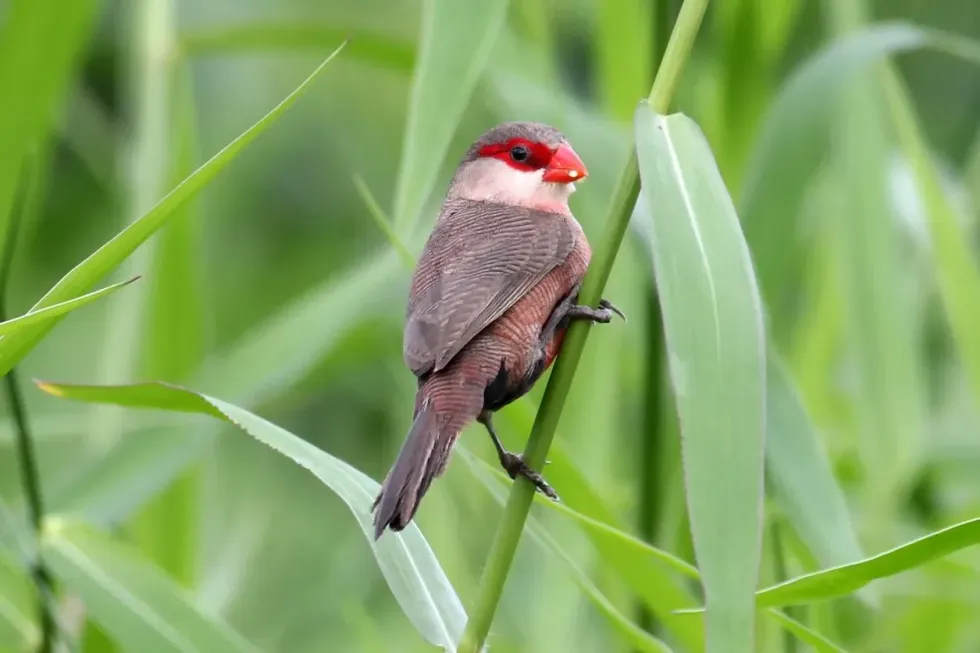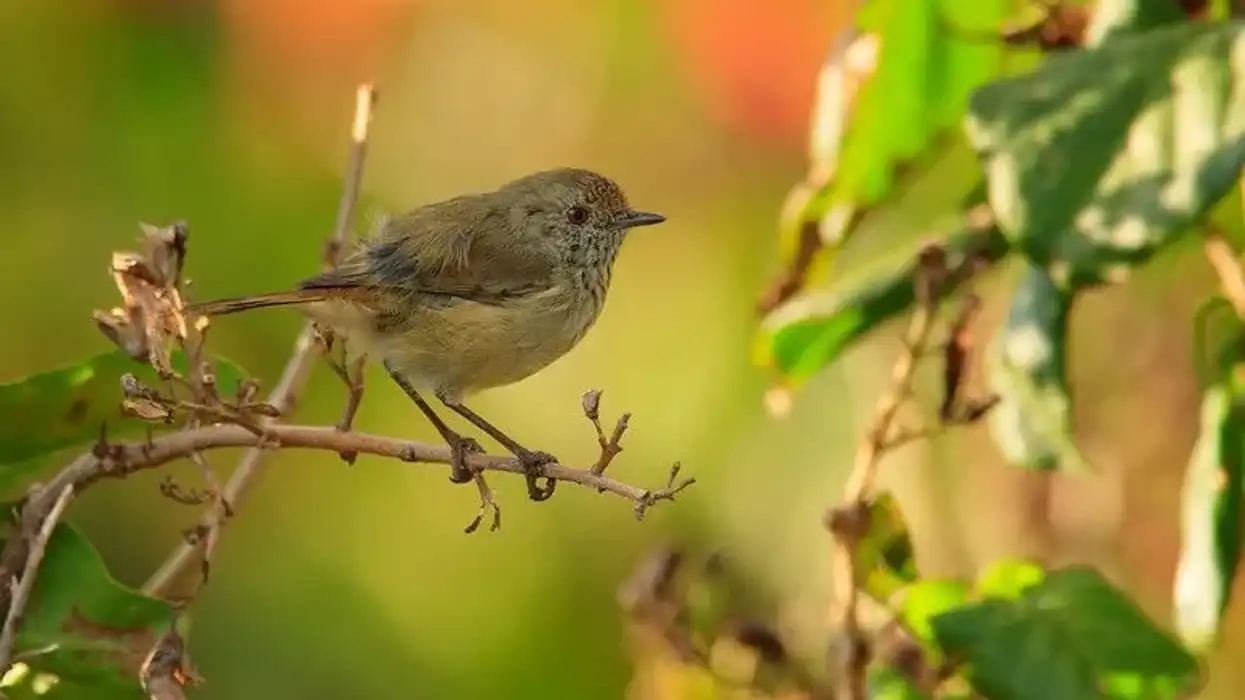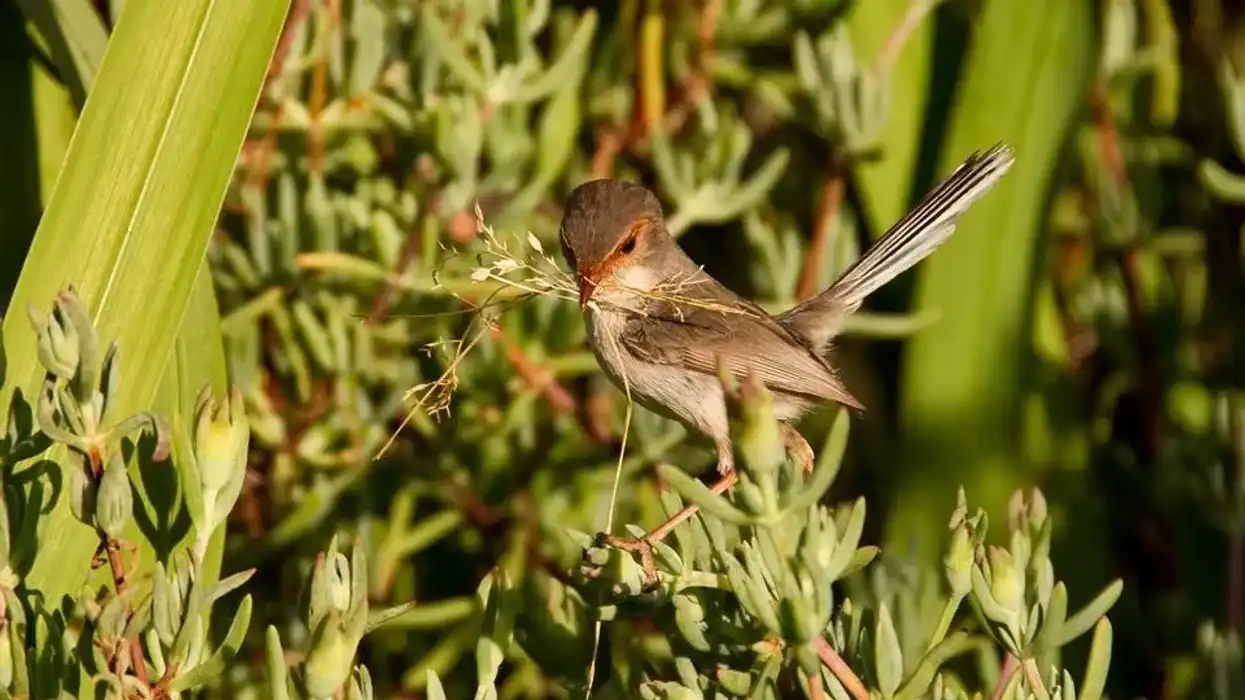The common waxbill gives credit to ‘sealing wax’ for their name. Their beaks and the red stripe across their eyes shine with the same brilliance of bright red wax. Hence the name. These tiny finches are also known as the St. Helena waxbill.
Scientifically known as Estrilda astrild, this bird is a native of sub-Saharan Africa. As a result of caged birds escaping, this species has been introduced to other urban parts of the world like the Mediterranean Basin, Taiwan, Indian islands, and the Americas.
They were first reported being seen in Hawaii in the late '70s. These birds successfully naturalize in the areas they are introduced to.
Their ability to adapt to new environments, new food sources, and most importantly their high reproductive rate are the reasons for this. Their populations are now aplenty.
Despite being listed as a Least Concern species in terms of their number; the Common Waxbill’s habitat is still under threat from human intervention. These African birds are sometimes perceived as pests or as a nuisance to crops and therefore attacked.
Their quick reflexes, fast motion, and intelligent nesting habits protect them from other bigger predators like birds of prey, snakes, and carnivorous mammals.
For more interesting animal facts, check out our articles on the little penguin and short-eared owl.
Common Waxbill Interesting Facts
What type of animal is a common waxbill?
St Helena Waxbills are birds native to sub-Saharan Africa. The scientific name for the species is Estrilda astrild. This species of bird belongs to the Estrildidae family and Estrilda genus. They are of the order Passeriformes.
What class of animal does a common waxbill belong to?
The common waxbill (Estrilda astrild) belongs to the class of Aves within the animal kingdom. This finch species belongs to the Estrildidae family and Estrilda genus. They are of the order Passeriformes.
How many common waxbills are there in the world?
The Common Waxbill populations are large in the wild, although no accurate estimate has been computed as yet. This finch species' populations are not under threat at present. And because of their high breeding and reproductive rates as well as easy habitat adaptability, the common waxbill Estrilda Astrild now has an estimated global extent of occurrence of 10,000,000 km2.
Where does a common waxbill live?
They prefer to live in grassy wetlands and marshes with good access to seeds and water. The St Helena Waxbill lives in regions with tall grass. They prefer shriveled shrubs and cultivated areas like gardens, grass paths, farms, and plantations near water bodies. This finch bird can also be found in tropical forest clearings and edges.
They are found generally in Southern Africa, mostly in regions like Senegal, Ethiopia, and Botswana, and generally throughout the range of sub-Saharan Africa. The common waxbill (Estrilda astrild) bird has been introduced in countries like Portugal, Trinidad, Brazil, and Taiwan.
They’ve also been introduced to islands like Hawaii in America (common waxbill Honolulu), Tahiti, Mauritius, Seychelles, Puerto Rico, and Bermuda. The Hawaii common waxbill of America is popular.
What is a common waxbill's habitat?
Common waxbills can be found in damp grass fields, marshes, and wetlands. They prefer shriveled shrubs and cultivated areas like gardens, grass paths, farms, and plantations near water bodies. This finch bird can also be found in tropical forest clearings and edges.
They prefer open, warm habitats in the wild. They are cold-sensitive and prefer a warmer climate. This is why they are popular in many islands in America (Hawaii birds common waxbill).
Who do common waxbills live with?
The Estrilda astrild common waxbill birds live in groups or flocks. During the breeding season, these birds pair off and live together as a monogamous couple in their nest. A group of finches is called a charm, trembling, or company.
How long does a common waxbill live?
The common waxbill's lifespan spans an average of four years in the wild.
How do they reproduce?
The Common Waxbills courtship patterns are very interesting. Once they choose a mate, they begin their courtship ritual with a ‘curtsy’ and a song exchange.
Mating is an elaborate ritual for the proud Common Waxbill male. Other females who are subject to their unwarranted attention sometimes flee and avoid them. Breeding takes place between the male and female that didn't flee.
Nests are an integral part of reproduction and almost all birds construct a nest to protect and raise their young. Common waxbills build sturdy and intricate pear-shaped nests with a narrow passage made of crisscrossed grass stems inside cavities amongst dense vegetation.
During the breeding season, the protective male Waxbills can sometimes become aggressive and territorial around their nest. Common waxbill fighting is seen during this time in this bird species.
Couples are monogamous and mate with only one partner. They breed often throughout the year between September to June based on the rainy season which increases the availability of food.
Each clutch size ranges between four and six eggs. Incubation lasts for almost two weeks and the couple shares the responsibility of feeding and raising the young.
Common Waxbill hatchlings fledge when they are 17–21 days old. Since both parent finches take turns incubating the eggs and raising the young in the family, the nest serves as a resting ground for the other parent.
What is their conservation status?
The common waxbill, known as the St Helena Waxbill, has been listed as Least Concern by the International Union for Conservation of Nature Red List of Threatened Species. Humans are, however, still the main threat to their habitat and surroundings.
Sometimes this bird species is considered a ‘pests’ to farmers when they are a threat to their crops and seeds.
Common Waxbill Fun Facts
What do common waxbills look like?
The Common Waxbills have a slender body with short rounded wings and a long graduating tail. These finches are gray and brown with dominant red coloration on their beaks and ‘bandit’ like a stripe across their eyes.
The distinguishing red colors appear as if dipped in red wax and the common waxbill beak color gives the bird its name. Their legs and feet are grayish-black.
The female Waxbills are smaller than the males but are slightly paler with lesser red coloration on the belly. Juvenile Common Waxbills are also duller with little or no red on the belly and a black bill.
Estrilda astrild are small, at approximately 4-5 in, and are often seen darting around fields. These birds weigh about 1.75 oz. Their average weight is 0.3 oz (8.9 g). Their wings span about 4.5 in.
They have subtle dark bars throughout their body and a prominent dark vent. Their flight is undulating in a smooth wave-like manner. These birds are also known as Pheasant finches.

How cute are they?
The common waxbill fully mature is extremely cute, with its rounded wings, belly, and waxy red bill. Even hatchlings are super cute.
How do they communicate?
The Common Waxbills are quite loud and noisy when they want to be vocal. They emit various twittering and buzzing high pitch sounds.
Their song is harsh and nasal with both males and females singing in different notes. Young Common Waxbills are so noisy that they beg for food with loud calls between the ages of 10-20 days. They are highly dependent on the adults for food until they leave the nest and for a few days after.
How big is a common waxbill?
The Common Waxbill size is very small, measuring around 4-5 in.
How fast can a common waxbill fly?
These birds are swift flyers.
How much does a common waxbill weigh?
These birds weigh about o.75 oz. Their average weight is 0.3 oz (8.9 g).
What are the male and female names of the species?
The common waxbill female and male don't have separate names. They are called the common waxbill itself.
What would you call a baby common waxbill?
Baby Common Waxbills are called chicks or nestlings. The nestlings have dull white gape flanges along the sides of their mouth.
The Pin-tailed Whydah is a brood parasite that takes advantage of the nurturing tendencies of the Common Waxbill and lays its eggs in the same nests. They allow the Common Waxbills to raise their young. Since the young look alike, the St. Helena Waxbills raise them all as one.
What do they eat?
Grass seeds are an important part of the St. Helena Waxbills diet. They are often seen picking on flower heads by clinging to the sides of the stems.
They also search for seeds on the ground and are seen zipping across grassy patches of land. These gregarious seedeaters sometimes add fruits and berries to their diet as well. During the breeding season, there is a higher requirement of protein in their diet.
So, the Common Waxbills adapt and feed on insects and flying termites as well. Water is a necessity because seeds contain hardly any moisture.
Are they friendly?
The Common waxbills, Estrilda astrild, are very social birds. They are found in small flocks during the breeding season and larger flocks at other times. A group of finches is often called a charm, company, or a trembling and they sometimes number in the thousands.
These birds are very friendly with humans too. They have adapted to almost every region that the captive birds are said to have been released in. Their numbers are quite large and therefore rarely seen domesticated.
Would they make a good pet?
Common Waxbills do fit the bill of an easy-to-maintain pet. But their numbers are quite large in the wild and therefore a common waxbill pet is not a popular occurrence. They are quite popular in zoos, however. These social birds are also found in groups with other varieties of finches.
These passerine birds prefer tropical, warmer climates. They are cold-sensitive and cannot live in places where the temperature is below 18 degrees Celsius. These Common Waxbills are very popular and easy to maintain in captivity. They are said to have an approximate global extent of occurrence of 10,000,000 sq. km.
Did you know...
Because of their size, these birds are common prey to larger carnivores like snakes.
Nest construction is a very interesting aspect to learn more about, with this species of bird. Throughout the nesting period, Common Waxbills are known to scatter the scat of other carnivores, indigestible hair, and bones of vertebrae around their nests.
The fecal matter acts as a deterrent to discourage other predators from sensing the existence of the young finches and from warding them away. A rudimentary second nest or the 'cock’s nest' is sometimes built above the existing nest.
How can you tell a male and female common waxbill apart?
Females are smaller than males but they are paler and have less red on the belly. The male and female of this species have different singing styles. Preening is also a common occurrence between them.
What sounds does the common waxbill make?
The Common Waxbills are famous for making a variety of twittering and buzzing calls and distinctive high-pitched sounds. The simple song is harsh and nasal.
Here at Kidadl, we have carefully created lots of interesting family-friendly animal facts for everyone to discover! Learn more about some other birds from our shoebill facts, and roseate spoonbill fun facts pages.
You can even occupy yourself at home by coloring in one of our free printable Common Waxbill coloring pages.










